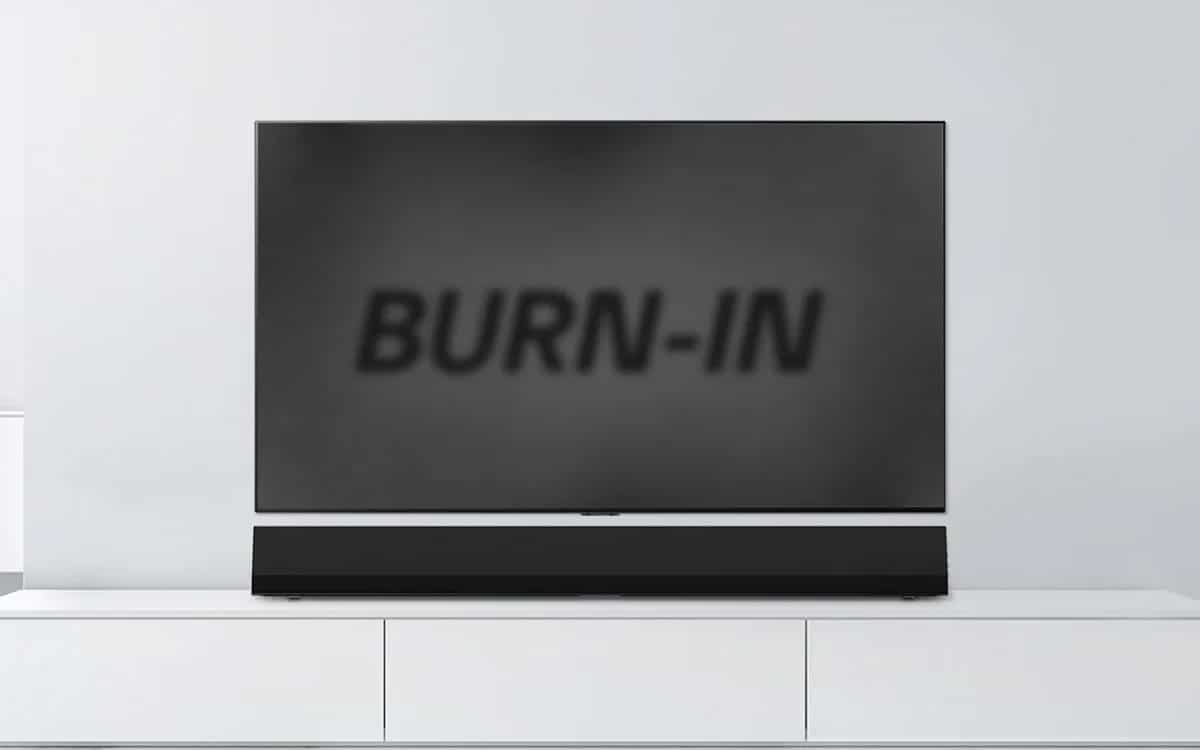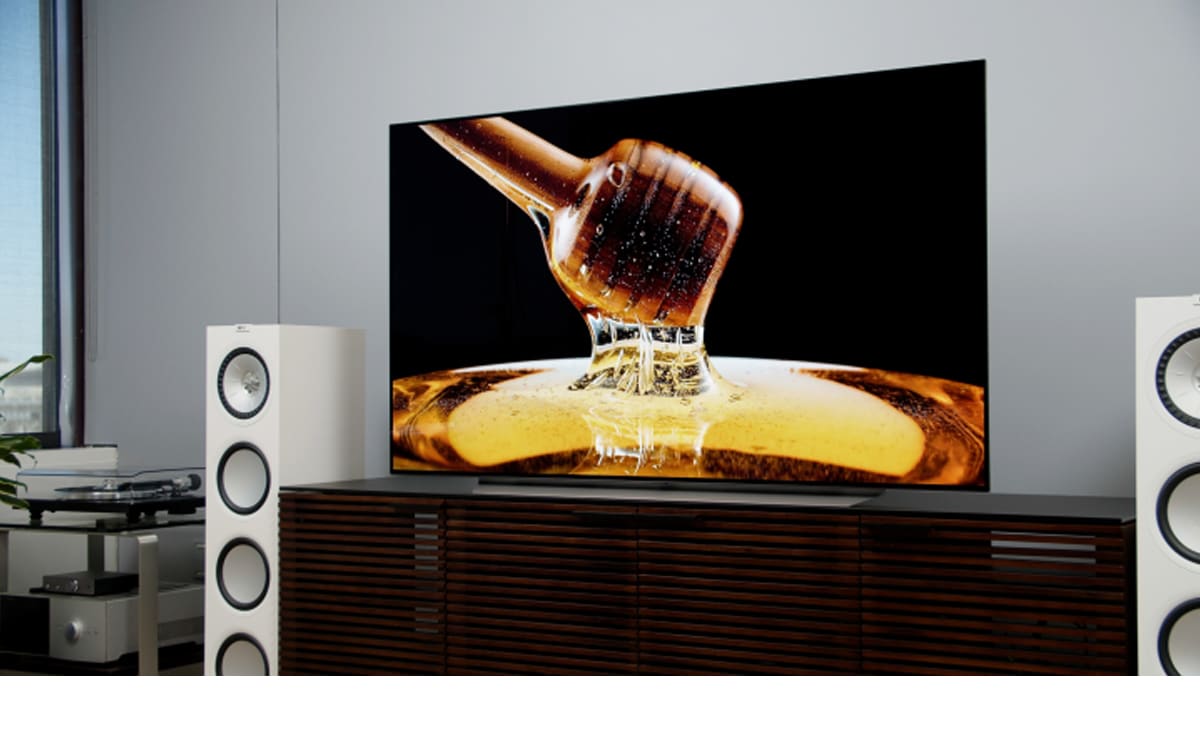But what exactly does burn-in refer to? And why is it so feared by so many tech enthusiasts? If you suspect that your TV may have developed a case of burn-in, or you simply want to do your utmost to prevent it, then you’ll want to keep reading down below.
In this article, we’re going to take you through exactly what burn-in is, why it is such a persistent problem, and most important of all, how you can prevent it from befalling your TV!
What Is TV Burn In?
Burn-in refers to a situation in which highly visible and persistent marks are left permanently etched onto the surface of a TV screen. No matter what content you view after burn-in occurs, the image will remain etched into the screen. In some cases, burn-in can be so severe that it becomes impossible to ignore whenever using the screen.
What Causes TV Burn In?
Burn-in occurs when a static image is left on a TV screen for a prolonged amount of time, causing that specific image to leave an impression on the screen. Burn-in can also occur in smaller forms. For instance, channel logos that appear in the corners of your favourite broadcast shows can directly lead to burn-in.
Many cases of burn-in actually occur accidentally, such as when an individual falls asleep on the sofa, without turning off the TV screen. Pausing a show, or leaving a DVD menu open can become incredibly dangerous if you forget to turn off the screen after a prolonged period.
As a result, many TVs make use of power-off timers. Once a certain amount of time has elapsed, without any input from the user, the TV will turn itself off, to allow the screen to rest. It is highly suggested to make use of power-off timers, to help prevent burn-in from occurring accidentally.
Why Does TV Burn-In Happen To OLED TVs?
OLED TVs, in particular, are highly susceptible to burn-in, thanks to how they operate. OLED TVs differ from other TVs in how they are illuminated. Instead of making use of a backlight, the individual pixels in OLED TVs actually illuminate themselves independently. While this does lead to a much sharper image and greater brightness, it also increases the odds of burn-in.
Whenever an OLED TV displays an image, certain amounts of energy are sent to individual pixels. Of course, while an image is in motion, the amount of energy heading to a single pixel will continually change. This allows plenty of time for a pixel to cool down.
However, if a static image is left on an OLED screen for a prolonged period, this will cause individual pixels to use a consistently high amount of energy. As an individual pixel is subjected to a continuous flow of high energy, it will naturally begin degrading and tiring out. If this flow of energy continues for an extended period, it will eventually cause the pixels to lose their strength. This results in burn-in.
Burn-in is an issue directly caused by pixels burning out due to excessive energy levels. As such, it is an issue that commonly affects OLED TVs. Luckily, many OLED TVs come with power-off timers to prevent this!
Can TV Burn In Occur On A QLED TV?
Not all major TVs on the market are susceptible to developing burn-in! QLED TVs, in particular, are actually invulnerable to burn-in. 4K QLED TVs are very unique in that they don’t actually use pixels, but instead make use of ‘Quantum Dot Technology’ to replicate colours.
Quantum dots themselves are actually small semiconductors that, when subjected to energy, are able to recreate highly specific colours. QLED TVs make use of backlight to allow those colours to pop. Because the quantum dots don’t produce light in the same way that OLED pixels do, they are not susceptible to developing burn-in!
Can TV Burn In Be Fixed?
Unfortunately, burn-in is totally irreversible, and cannot be fixed. No matter how long you wait for the problem to resolve itself, it never will.
This is why it is so important to prevent burn-in before it has a chance to occur. Make sure to take advantage of all of the built-in safety mechanisms that help your TV to prevent the issue. Make use of power-off timers, and pixel shift functions.
If you want to remove the burn-in after it has occurred, it would be possible to have the screen replaced, however, you should keep in mind that this is very costly. The screen is the hardest and most expensive part of a TV to replace. If your TV is particularly old, it may be worth replacing it.
Can You Ignore Burn In?
Luckily, there is a silver lining when it comes to burn-in. Cases of burn-in can vary massively in severity, with some cases being so bad that it is impossible to use the TV. However, in some cases, burn-in can be very minor, and it may be possible to ignore it.
If your TV is only suffering from a minor case of burn-in, then you will be able to overlook it by simply upping your brightness while in use. Of course, it is important to ensure that you turn your TV off when not in use and turn the brightness down as often as you can.

How Do You Prevent TV Burn In On Your TV?
Whether you’ve experienced the dreaded burn-in yourself, or you want to keep it from ever happening to your brand new 4K OLED TV, you’ll definitely want to keep these tips in mind. Each will help you not only to prevent burn-in but also generally extend the life of your TV!
Make Use Of Power-Off Timers
We’ve mentioned power-off timers plenty of times throughout this article, but we really cannot overstate their importance. When your TV notices that there has been a lack of input for an extended period, it will automatically shut itself off. While this may seem like an annoyance on the surface, it is incredibly useful.
Power-off timers help to prevent accidentally leaving the screen on static images. We’ve all fallen asleep on the sofa at some point or another. Power-off timers help to ensure that no static images are able to stick around and put a TV screen at risk.
Power-off timers can be toggled via the settings of most major TV models, but we recommend leaving the function active. It can really take a load off of your mind.
Use Pixel Shift
Pixel shift is an ingenious technology employed in most major 4K TVs, and it is totally worth taking advantage of. Pixel shift operates automatically by slightly shifting an image on screen, to allow individual pixels to receive slightly less energy, especially when displaying static images.
This is a great feature to make use of especially if you plan on using your TV to watch live news coverage. Live news programs often make use of static elements, such as news tickers, which remain prominent on the screen throughout entire broadcasts. Pixel shift will simply ensure that pixels associated with static elements are not subjected to the same amounts of energy for too long.
Make Use Of Proprietary Functions
Many major TV manufacturers include their own proprietary technologies to help prevent burn-in from occurring. It’s a great idea to take advantage of these functions, as they work to the specific needs of an individual TV.
LG 4K OLED TVs, in particular, make use of a ‘Pixel Refresher’. This feature acts by actively refreshing each of the pixels individually once the screen has been turned off. The TV will target the most used pixels, to allow them to cool down, and thus prevent burn-in.
One of the most ingenious functions found on Samsung 4K OLED TVs is the ‘Adjust Logo brightness’ function. This incredibly useful function seeks to actively identify static logos found on broadcast channels, and dim them down, to prevent them from using up significant energy to display. This goes a long way in protecting individual pixels from burn-in!
Many TVs come with their own useful features that help to prevent burn-in in their own unique ways. Make sure to carefully observe the manual of your model to see what it can offer!
Lower Screen Brightness
One of the easiest steps towards preventing burn-in on any TV is simply turning down the brightness of the screen. Remember, burn-in occurs when individual pixels are subjected to high amounts of energy. This leads to their increased degradation. If you simply lower your brightness wherever you can, you can reduce energy usage, and slow the degradation of individual pixels.
Lowering screen brightness also helps to prevent eye strain, so it truly is a win-win solution!
Make Use Of Pixel Cleansing
Many modern 4K OLED TVs offer the ability for users to perform an optional pixel cleansing. Pixel cleansing allows a TV to identify potentially affected pixels and ‘refresh’ them, to help ensure their continued health. This process can differ from model to model. Sometimes pixel cleansing can take only 10 minutes, with the screen off, or can even occur while using the screen.
Philips 4K OLED TVs, amongst others, allow users to access the pixel cleansing function directly from the system settings, whenever they need it.
We know it sounds obvious, but it often bears repeating just how important it is to turn your TV off when not in use. It can be very easy to pause your favourite Netflix series for “Just a minute”, only to end up leaving the screen illuminated for numerous hours, forgetting that you left it on.
If you ever find that you need to step away from your TV for an extended period, we would recommend turning the screen off. It will only take a couple of seconds to get back into your show once you return.
To help prevent accidentally leaving the screen on, it is also best to make good use of power-off timers and screensavers. These make a great backup, should you ever accidentally leave the screen on. These are also great if you are prone to falling asleep in front of the screen!
Frequently Asked Questions
Is TV Burn-In Bad?
Yes. In just about every way, burn-in is bad. Cases of burn-in can vary in severity. However, if a case is severe enough, it can directly impact your ability to enjoy your favourite TV shows and films. Strong burn-in can make it difficult to focus, as the static image of the burn-in can be incredibly distracting.
Do All OLED TVs Suffer From Burn-In?
While all OLED TVs are susceptible to burn-in, not all OLED TVs have to develop the issue. Burn-in occurs as a result of improper care, by leaving a screen on a static image for extended periods. Not only is this bad for the screen, but also your energy bills! Luckily, it is incredibly easy to prevent burn-in from ever affecting your screen.
What Is The Lifespan Of An OLED TV?
OLED TVs can easily last a number of years, provided they are cared for adequately. If you were to take good care of your OLED TV, you could expect it to last you over 10 years, which is around 100,000 hours of total watch time! OLED TVs are incredibly hardy. While they may be susceptible to screen burn, they can last you many years.
Is It Bad To Leave An OLED TV On All Night?
Absolutely. Leaving an OLED TV on all night will very quickly shorten the total lifespan of the TV, as well as make it far more susceptible to burn-in. It is highly recommended to turn off your TV whenever it is not in use. If you think you may leave it on by accident, then make sure to use power-off timers as a great back-up measure.






0 Comments